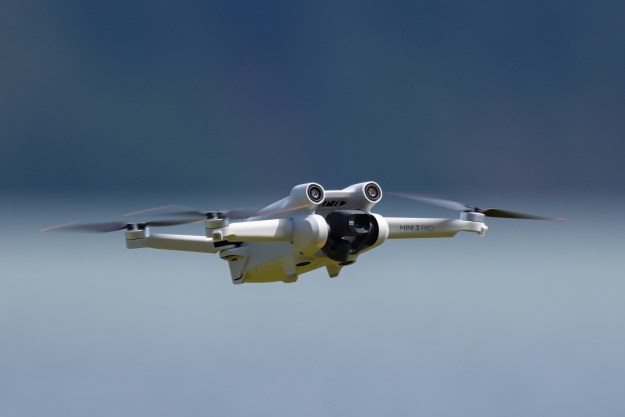I can’t believe it, but after several years of flying drones, I finally crashed one. Worse yet, the thing didn’t even lift off the ground before it crashed, uneventfully, only a few short feet away from when I was trying to get it to take off. For the first time in my short drone-piloting life, I was afraid of flying a drone. And it’s just not any drone here, it’s the brand new DJI FPV.
Even before I put everything together for my first test flight, I felt some anxiety because this was my first solo exposure to an FPV system. Traditionally speaking, I fly my drones using a remote controller with my smartphone attached to it, but this was totally different. For one, it’s an odd feeling having to wear FPV (first person view) goggles in order to pilot a drone, but it’s necessary because of the DJI FPV’s new OcuSync 3.0 transmission technology.
Secondly, it felt like I was put in control of a souped-up Formula One race car — so you can imagine the anxiety I was feeling the moment I turned it on. I specifically mention this example of a Formula One race car because I already know how to drive, whereas I equate piloting my first drone to the first time driving a car. You sort of expect the experience to help you transition to something more comprehensive, but that wasn’t the case here.
Raw power
Looking at the specs of the DJI FPV, it shouldn’t be in the hands of a rookie pilot because of its zippy acceleration (0 to 62mph in two seconds) and top speed of 87 mph. Add to that the closed feeling of wearing FPV goggles, and I was already hesitant when I powered on the drone. I knew right away I was dealing with something truly beastly here, especially with the minor detail of the drone “rumbling” its motors upon startup — I could literally feel its raw power!

Eventually, I found the courage to finally start my liftoff. After pointing the joysticks on the controller in a downward, diagonal direction, the four propellers came to life. So far, so good. Traditionally speaking, I would press the on-screen liftoff button in the DJI Fly app to launch a drone into the air, but this was a different affair because there’s no smartphone or app involved. Therefore, I did the only instinctive thing I could think of at that moment, which was to press up on the left joystick.
I thought this would lift the DJI FPV off the ground a bit, but instead, it made the motors rev harder and faster. It was deafening, louder than anything I’ve ever tested. Seriously, I thought the darn thing was going to launch itself much like a rocket. At that point, I eased my thumb off the joystick and the sound of the motors went back down to their normal level. I was dumbfounded because I thought this would’ve worked.
Point of no return
With my frustration starting to settle, I decided to simply try again by slowly pressing up on the left joystick until it was at its maximum threshold. By this time, the sound was at an unbearable level again, but I saw a slight wiggle, which made me think that it just needed to get the motors up to full strength. I was sadly wrong because the next thing I know, the front of the DJI FPV began to tip — so I eased down on the left joystick again.
This is where things just went to hell because I was so frustrated that I again pushed the left joystick up to its maximum point. From here, it began to slightly “hop,” and the intensity of the propellers made it begin to tip over. That was the point of no return, because the next thing I know, it flipped upside down hard onto the pavement — with the propellers still whizzing away. After a few seconds of confusion, I was panicking because I was trying to figure out how to stop the drone. Eventually, I held the two joysticks in the same inward, diagonal direction, much like I did turning them on.

The damage was done. It didn’t even properly lift off from the ground and all four propellers were chipped beyond recovery. Thankfully, the rest of the drone was spared, with only superficial scratches throughout its body. The next day, I swapped out the damaged propellers with the fresh set included in the Fly More Combo package. However, the same issue persisted — so I scrapped the flight altogether.
User error
After some research and talking to DJI’s team about what went wrong, I was told that I could have installed the propellers the wrong way. And you know what? They were right. Actually, it wasn’t the way I installed them, but what combination I used. In the box, there are two smaller boxes, each filled with four propellers. I installed all four from one of the small boxes onto the DJI FPV. However, I was supposed to actually install two propellers from one box, then another two from the other box. The one set of propellers have a red circle around their base, while the other set didn’t have them.

Once I realized my oversight in reading the instructions on installing the propellers, it hit me why the drone didn’t want to lift off. When the next clear day arrived, I turned on the drone and hesitantly pressed up on the left joystick. To my relief, it finally lifted off the ground properly! She lived to fly another day.
Editors' Recommendations
- DJI Mini Pro 4 leak appears to reveal the drone’s specs
- DJI’s 2022 drone contest offers record prize pool
- Is DJI about to release a new drone?
- Watch this Mavic 3 drone soar above the world’s highest mountain
- DJI’s latest Mavic 3 update made me love the drone all over again



